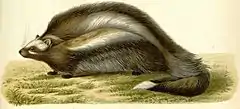| Lophiomys | |||
| Milne-Edwards, 1867[1] | |||
 Przedstawiciel rodzaju – grzywak afrykański (Lophiomys imhausi) na ilustracji z 1867 roku | |||
| Systematyka | |||
| Domena | |||
|---|---|---|---|
| Królestwo | |||
| Typ | |||
| Podtyp | |||
| Gromada | |||
| Podgromada | |||
| Rząd | |||
| Podrząd | |||
| Infrarząd | |||
| Nadrodzina | |||
| Rodzina | |||
| Podrodzina | |||
| Rodzaj |
grzywak | ||
| Typ nomenklatoryczny | |||
|
Lophiomys imhausii Milne-Edwards, 1867 | |||
| Synonimy | |||
|
| |||
| Gatunki | |||
| |||
Grzywak[4] (Lophiomys) – rodzaj ssaków z podrodziny grzywaków (Lophiomyinae) w obrębie rodziny myszowatych (Muridae).
Zasięg występowania
Rodzaj obejmuje gatunki występujące we wschodniej Afryce[5][6].
Morfologia
Długość ciała (bez ogona) 252–301 mm, długość ogona 145–205 mm; masa ciała 590–920 g[7][8].
Systematyka
Rodzaj zdefiniował w 1867 roku francuski zoolog Alphonso Milne-Edwards na łamach L’Institut[1]. Na gatunek typowy wyznaczył grzywaka afrykańskiego (L. imhausi).
Etymologia
- Lophiomys: gr. λοφιον lophion ‘czubek’, zdrobnienie od λοφος lophos ‘grzebień, czub’; μυς mus, μυος muos ‘mysz’[9].
- Phractomys: gr. φρακτος phraktos ‘chroniony’, od φρασσω phrassō ‘wzmocnić’; μυς mus, μυος muos ‘mysz’[10]. Gatunek typowy: Phractomys aethiopicus W. Peters, 1867 (= Lophiomys imhausii Milne-Edwards, 1867).
- Phragmomys: gr. φραγμος phragmos ‘żywopłot’[11]; μυς mus, μυος muos ‘mysz’[12]. Gatunek typowy: Lophiomys imhausii Milne-Edwards, 1867.
Podział systematyczny
Do rodzaju należy jeden występujący współcześnie gatunek[13][8][5][4]:
- Lophiomys imhausi Milne-Edwards, 1867 – grzywak afrykański
Opisano również gatunki wymarłe[14]:
Przypisy
- 1 2 A. Milne-Edwards. [Notka bez tytułu]. „L’Institut”. 35 (1727), s. 46, 1867. (fr.).
- ↑ W.C.H. Peters. [Notka bez tytułu]. „Zeitschrift für die gesammte Naturwissenschaften”. 29, s. 195, 1867. (niem.).
- ↑ W.C.H. Peters. [Notka bez tytułu]. „Sitzungsberichte der Gesellschaft Naturforschender Freunde zu Berlin”. Jahrgang 1867, s. 19, 1868. (niem.).
- 1 2 Nazwy polskie za: W. Cichocki, A. Ważna, J. Cichocki, E. Rajska-Jurgiel, A. Jasiński & W. Bogdanowicz: Polskie nazewnictwo ssaków świata. Warszawa: Muzeum i Instytut Zoologii PAN, 2015, s. 240. ISBN 978-83-88147-15-9. (pol. • ang.).
- 1 2 C.J. Burgin, D.E. Wilson, R.A. Mittermeier, A.B. Rylands, T.E. Lacher & W. Sechrest: Illustrated Checklist of the Mammals of the World. Cz. 1: Monotremata to Rodentia. Barcelona: Lynx Edicions, 2020, s. 458. ISBN 978-84-16728-34-3. (ang.).
- ↑ D.E. Wilson & D.M. Reeder (redaktorzy): Species Lophiomys. [w:] Mammal Species of the World. A Taxonomic and Geographic Reference (Wyd. 3) [on-line]. Johns Hopkins University Press, 2005. [dostęp 2021-01-19].
- ↑ Ch. Denys, P. Taylor & K. Aplin. Opisy gatunków Muridae: Ch. Denys, P. Taylor, C. Burgin, K. Aplin, P.-H. Fabre, R. Haslauer, J. Woinarski, B. Breed & J. Menzies: Family Muridae (True Mice and Rats, Gerbils and relatives). W: D.E. Wilson, R.A. Mittermeier & T.E. Lacher (redaktorzy): Handbook of the Mammals of the World. Cz. 7: Rodents II. Barcelona: Lynx Edicions, 2017, s. 650. ISBN 978-84-16728-04-6. (ang.).
- 1 2 Class Mammalia. W: Lynx Nature Books: All the Mammals of the World. Barcelona: Lynx Edicions, 2023, s. 293. ISBN 978-84-16728-66-4. (ang.).
- ↑ Palmer 1904 ↓, s. 383.
- ↑ Palmer 1904 ↓, s. 534.
- ↑ Jaeger 1959 ↓, s. 195.
- ↑ Jaeger 1959 ↓, s. 160.
- ↑ N. Upham, C. Burgin, J. Widness, M. Becker, C. Parker, S. Liphardt, I. Rochon & D. Huckaby: Treeview of Mammalian Taxonomy Hierarchy. [w:] ASM Mammal Diversity Database (Version 1.11) [on-line]. American Society of Mammalogists. [dostęp 2023-10-09]. (ang.).
- ↑ J.S. Zijlstra, Lophiomys Milne-Edwards, 1867, Hesperomys project (Version 23.8.1), DOI: 10.5281/zenodo.7654755 [dostęp 2023-10-09] (ang.).
- ↑ H.B. Wesselman, M.T. Black & M. Asnake: Small mammals. W: Y. Haile-Selassie & G. WoldeGabriel (redaktorzy): Ardipithecus kadabba: Late Miocene Evidence from the Middle Awash, Ethiopia. Berkeley (California): University of California Press, 2009, s. 123. ISBN 978-0-520-25440-4. (ang.).
- ↑ J.-P. Aguilar & J. Michaux. Un Lophiomys (Cricetidae, Rodentia) nouveau dans le Pliocène du Maroc; rapport avec les Lophiomyinae fossiles et actuels. „Paleontologica I Evolució”. 23, s. 205–211, 1990. (fr.).
Bibliografia
- T.S. Palmer. Index Generum Mammalium: a List of the Genera and Families of Mammals. „North American Fauna”. 23, s. 1–984, 1904. (ang.).
- E.C. Jaeger: Source-book of biological names and terms. Wyd. 3 (Revised second printing). Springfield: Charles C. Thomas, 1959, s. 1–316. (ang.).
Identyfikatory zewnętrzne:
This article is issued from Wikipedia. The text is licensed under Creative Commons - Attribution - Sharealike. Additional terms may apply for the media files.